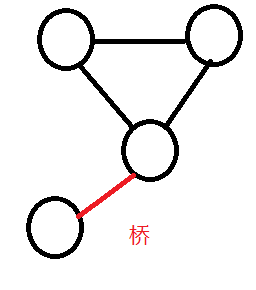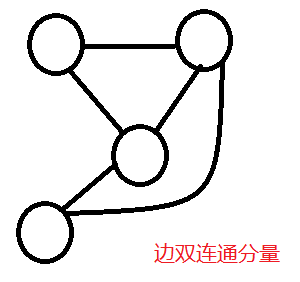tarjan
终于来到了差点让我破防的tarjan
争取说明白吧
定义:
1. 桥:指去掉该边,其原本所在的强连通分量变为两部分(即不再是强连通分量)

2. 边双连通分量:即没有桥的无向连通图

3. 强连通分量:即没有桥的有向连通图
求无向图的边双连通分量的数量
我们的思路是,从某一节点作为根节点开始dfs遍历图,使用一个$dfn$记录该节点的$dfs$序
再用一个$low$,记录这个点可以往上跑,跑到的最高的点的$dfn$的值
显然,如果$dfn[i] > low[i]$,则说明该节点可以查到自己的祖先,记作种类2
那如果$dfn[i] = low[i]$ ,就说明这个点就是所在连通分量的最上面一个点,记作种类1
我们开一个栈,然后访问到一个点就把这个点压入栈中
对于种类2,必然在栈中位于种类1的前面(因为后遍历到)
所以一旦发现点p为种类1,直接弹栈至p,其中弹出的所有元素都跟p在一个强连通分量里
代码如下:

#include<iostream> #include<cstdio> #include<stack> #define NUM 1010 #define FOR(a,b,c) for( int a = b;a <= c;a++ ) using namespace std; int n; int a[NUM]; struct bian{ int next,to; }; bian e[NUM]; int head[NUM]; int dfn[NUM],low[NUM]; int id[NUM]; int cnt,scc; void add( int x,int y ){ e[++cnt].next = head[x]; e[cnt].to = y; head[x] = cnt; } int timess; stack <int> st; bool ins[NUM];//判断这个点是不是已经在栈里了 void tarjan( int p ){ dfn[p] = ++timess; low[p] = timess;//更新时间戳 st.push( p );ins[p] = 1;//将该点压入栈中 for( int i = head[p];i;i = e[i].next ){ int to = e[i].to; if( !dfn[to] ){ //如果终点没有访问过 tarjan( to ); low[p] = min( low[p],low[to] ); }else if( ins[to] ) //已经在栈里说明之前已经访问过,是之前的点 low[p] = min( dfn[to],low[p] ); } if( dfn[p] == low[p] ){ //以下是一个独立的强连通分量 ++scc;//分量数++ int hao;//栈顶点编号 do{ hao = st.top(); st.pop(); id[hao] = scc;//该点所在的分量编号 }while( hao != p );//从栈顶到该点是一个连通分量 } } int m; int main(){ cin >> n >> m; FOR( i,1,m ){ //边数 int x,y; cin >> x >> y; add( x,y );//有向边 } FOR( i,1,n ) if( !dfn[i] ) tarjan( i ); cout << "\n\n"; FOR( i,1,n ) //输出每个点所在的连通块编号 cout << i << " " << id[i] << "\n"; return 0; }
边双连通分量





